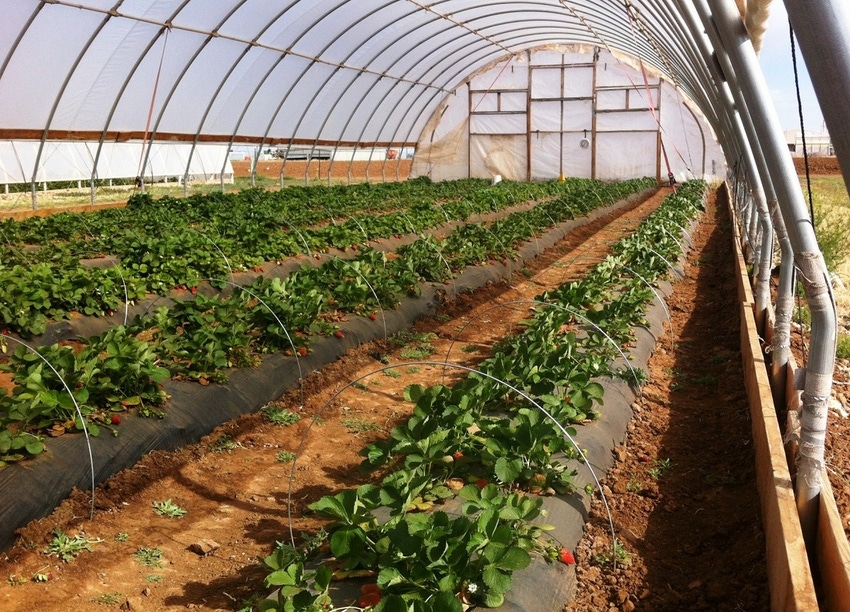
Producers and the U.S. Department of Agriculture show a great deal of interest in high tunnel farming, growing vegetables or floriculture in new high tunnel structures. USDA has even has offered robust funding programs to support the technology in recent years.
While production farmers would mostly scoff at the idea of growing crops inside a structure, applications for high tunnel farming seem to be increasing, with even a few production farms putting in test tunnels to check the water and cash in on farm-to-table marketing. Most high tunnel farming operations so far, however, are limited to small farms and independent or sustainable growers.
How does high tunnel farming differ from standard greenhouse farming operations?
Often called a poly-tunnel or hoop house, a seasonal high tunnel is basically a greenhouse without the controlled-environment equipment—heaters, large fans or humidity control devices that allow for year-round farming. Unlike greenhouses, they are constructed of lighter material, are rather easy to construct or assemble and to move if the need rises.
For the latest on southwest agriculture, please check out Southwest Farm Press Daily and receive the latest news right to your inbox.
A hoop house is technically a tunnel made of polyethylene, usually semi-circular, square or elongated in shape. The interior heats up because incoming solar radiation from the sun warms plants, soil, and other things inside the building faster than heat can escape. Air warmed by the heat from hot interior surfaces is retained in the building by the roof and wall.
The advantages to growing inside a high tunnel are many, not the least of which is a longer growing season that gets a jump on most spring crops and extends the fall growing season until the heart of the winter season.
Another advantage is that a tunnel provides a level of protection against problems associated with pests and diseases.
Gene Giacomelli, director of the College of Agriculture and Life Sciences at the University of Arizona, is a former field crop producer and supporter of poly-tunnel applications in farming.
“As a field grower who has lost many crops over the years and wishing I had a greenhouse at the time, I like the predictability of protected agriculture,” he says. “You have a lot more possibilities to save your crop and reach a market on a predicted date and to hit the high-price market by timing it.”
Floriculture to vegetables
Giacomelli said some floriculture growers have been transitioning slowly to vegetables, and others are expected to eventually leave the floriculture business to grow protected vegetables to take advantage of the popularity of farm-to-table and other types of direct marketing agriculture opportunities.
High Tunnels are ideal for vegetables, small fruits, cut flowers, and other crops. High tunnel investment can often be returned in less than one growing season and can reduce input costs throughout the growing season.
While you won't be seeing cotton, corn, wheat or any production crop grown
beneath a protective cover, high tunnels are perfect for smaller-scale vegetable, fruit or berry farming, and adaptable to growing flowers and other tropicals on a smaller scale.
According to Giacomelli, high tunnel growers have been given an incentive in recent farm bills in the form of USDA Specialty Crops Research grants. As a result, high tunnel production has exploded over the last dozen or so years.
"Many growers are learning to produce more and better-quality products in high tunnels, and the tunnels are a good, low-cost way to extend your growing season", Giacomelli added.
He says many high tunnel operators hope to expand not only the number of poly-tunnel structures but eventually to add heating and other environmental controls that will enable them to take advantage of year-round production.
Funding opportunities
USDA-Natural Resources Conservation Service (NRCS) administers and manages the High Tunnel System Initiative and the Environmental Quality Incentives Program (EQIP), which provides grants for high tunnel system applications as a conservation measure. According to NRCS, high tunnels assist farmers by improving plant and soil quality, reducing nutrient and pesticide transportation, improving air quality, and reducing energy use by providing consumers with a source for local produce.
NRCS accepts and processes EQIP applications on a continuous basis. However, each state may establish deadlines for one or more application periods in which to consider eligible requests for funding. Producers must submit a complete program application and other documentation to support eligibility to be considered for financial assistance through EQIP.
In Texas, interested producers can learn more about grants and their requirements at http://www.nrcs.usda.gov/wps/portal/nrcs/main/tx/programs/financial/eqip/ or by calling Mark Habiger, Assistant State Conservationist-Programs at 254-742-9881.
About the Author(s)
You May Also Like




